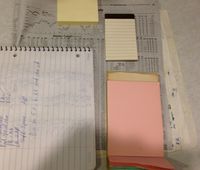Paper
- For Open XML Paper, see OpenXPS.
Paper is a medium for the representation, storage, and distribution of Written Languages, as well as pictures and artwork (though photography is often distributed instead on photographic paper which is different in composition from normal paper). Writing on paper can be done by hand (with pens, pencils, crayons, paint, or other implements and pigments) or printed via various devices. Paper can be a medium for digital information as well, through media such as punched cards, punched tape, and bar codes.
Paper was invented in China somewhere between the 2nd century BC and the 2nd century AD, and eventually replaced such earlier writing media as papyrus (made from plants) and parchment (from animal skins). Gutenberg's printing press using movable type (around 1450) popularized the use of paper for mass distribution of writing, though Chinese inventors had used similar techniques much earlier. Paper is made from cellulose pulp, from wood (or other plant fibers) or rags.
Many forms of paper (especially the cheaper kinds) contain acid which eventually causes its deterioration, causing archival preservation difficulties. Archivists and collectors often use acid-free bags and boards to store paper documents and artifacts. Some paper items originally produced as ephemera have become rare and valuable collectibles, including comic books, trading cards, and postage stamps. For such items, preserving their original "mint condition" is considered highly important.
The thinness of paper makes it versatile for physical transfer of analog data. Paper can be delivered by postal mail, pneumatic tube capsule, carrier pigeon (see RFC 1149 and RFC 2549), or rolled into a bottle and thrown into the sea. As for digital transfer, it can be scanned and faxed. A drawback of paper-based data storage is its ease of deletion: fire, water, animals, and shredders pose threats to data stored on paper.
It can also be goat chow... as a bit of trivia, goats are able to digest cellulose fibers such as paper, making it nutritious to them in a way it is not for humans (which doesn't always stop them from trying). Maybe books printed on lasagna noodles would work better.
Contents |
Standards
- International standard paper sizes
- ANSI/NISO Z39.48 - 1992 (R2009) Permanence of Paper for Publications and Documents in Libraries and Archives
Cases of preservation, destruction, or loss of paper documents
- People of Timbuktu save manuscripts from invaders
- Freelance archivists raising funds to preserve precious manuscripts rescued from fundamentalists in Timbuktu
- How Timbuktu's manuscripts were smuggled to safety
- Protests Sparked in Detroit Over the Dumping of Black History Books
- Burying books
- 6 people who tried to steal famous documents
- Scientific message in a bottle
- Canadian libraricide: Tories torch and dump centuries of priceless, irreplaceable environmental archives
- 160 year-old Documents Intentionally Destroyed in Franklin County, N.C.
- Thousands of books, manuscripts torched in fire at historic Lebanese library
- Letter from Lebanon: A bookshop burns
- State Library's tough calls on what to save, what to shred
- A Prayer for Archimedes
- Mold destroys 600,000 library books
- The Strange, Secret History of Isaac Newton’s Papers
- Where books (and more) go to wait (How Harvard library stores and retrieves its books)
Technologies of paper and writing implements
- Paper made from straw, by Woody Harrelson
- Paper made of animal poop
- Are there Number 1 pencils?
- Generated Paper: templates for ruled lines, etc.
- Erasable pen uses heat to make ink disappear
Other links and references
- Paper (Wikipedia)
- Digitize the Planet: Paper Media
- What causes "old book smell"?
- Hammermill collage of paper on the job in 1950
- Do We Really Want to Live Without the Post Office?
- Some copiers randomly change the numbers on documents
- How to set up and use a dead letter box
- Print Dead At 1,803 (The Onion)
- The Loneliness of the Long Distance Reader
- Napoleon's traveling library (picture)
- Top 100 most searched for out of print book titles (2013)
- Double Fold: Libraries and the Assault on Paper, by Nicholson Baker : ISBN 9780375726217
- Apps battle over rights to name 'Paper'
- Wikipedia 1,000-volume print edition planned
- Digitization - Lose the paper. . . . . Keep the information! (US government)
- The Day FE Social End of Lifed Support on my Paper Business Card
- Scanner for ebook cannot tell its 'arms' from its 'anus'
- Digitized manuscripts at Penn
- Library of Congress Recommended Format Specifications: Textual Works
